Triumph’s new Bonnie looks best in black, so we’re told. We’re also told that the new T120 is close in spirit to the original T120. Hmmm…
WORDS & PHOTOS BY Frank Melling, Triumph Motorcycles
Triumph are aiming for the new T120 to be the biggest seller in the Bonneville range which, in turn, will account for anywhere between 25% and 30% of all motorcycles sold by the Hinckley factory.
Fifty engineers – a huge number of staff by Triumph’s standards – have worked for nearly five years to bring this motorcycle to market. It is a machine which Triumph simply had to get right.
The T120 Bonneville is an extremely complicated motorcycle, not in terms of its engineering which is quite straightforward, but because of the highly complex marketing demands made of the bike.
The Bonneville heritage is immensely valuable, but it also looms threateningly over any machine carrying the iconic name. The practical, functional aspects of the machine can’t escape its historic heritage.
Let’s kill one myth straight away.
The story which is currently spreading like a successful flu virus is that Triumph’s 900cc Street Twin is a cheap, underpowered or beginner’s Bonneville, and that the real thing has to be the full fat, big boys’ 1200. Rarely has there been such a major misunderstanding of a motorcycle.

The truth is that the Street Twin is so radically different from the Bonneville that it could almost be made by a different manufacturer.
If you were coming from one of the great Meriden classics, like a 1968 Bonnie, it is arguable that the bike with which you would most empathise is the Street Twin because it rides like the best classic bike ever made, anywhere in the galaxy.
So, don’t think of the Street Twin as being a little or an inferior Bonnie, but more like a 2016 incarnation of a classic motorcycle.
However, today’s customers also demand a ‘real’ Bonneville with a big, rooty-tooty engine, big brakes and B-I-G attitude.
So if the Street Twin is the authentic replacement for a classic Bonnie, then perhaps the new T120 is more of a modern substitute for a Mk3 electric start Norton Commando.
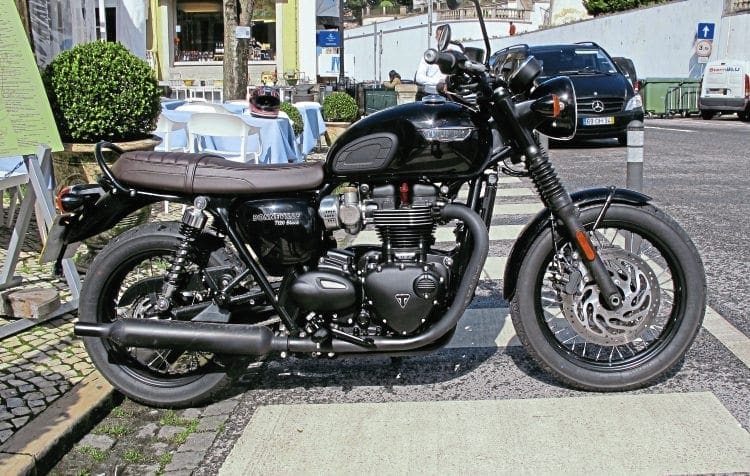
Saying that has probably earned me a lifetime ban from any other Triumph activity! But I make this observation on the basis that the big, somewhat lumpy, power surge which is the hallmark of a crisp 850 Commando is replicated – in a thoroughly modern and sophisticated way – by the 1200cc, eight-valve, 79bhp T120 motor.
By contrast, the Street Twin is truly the grandchild of Doug Hele’s Bonneville.
In the same way that 30-somethings like to buy T-shirts bearing pre-faded logos of the iconic old companies, so these good folk know exactly what a modern incarnation of a Bonneville should be. This is precisely what Triumph have provided.
For example, Triumph have gone to an inordinate amount of trouble to make the twin fuel injectors look like Amal Monobloc carburettors.
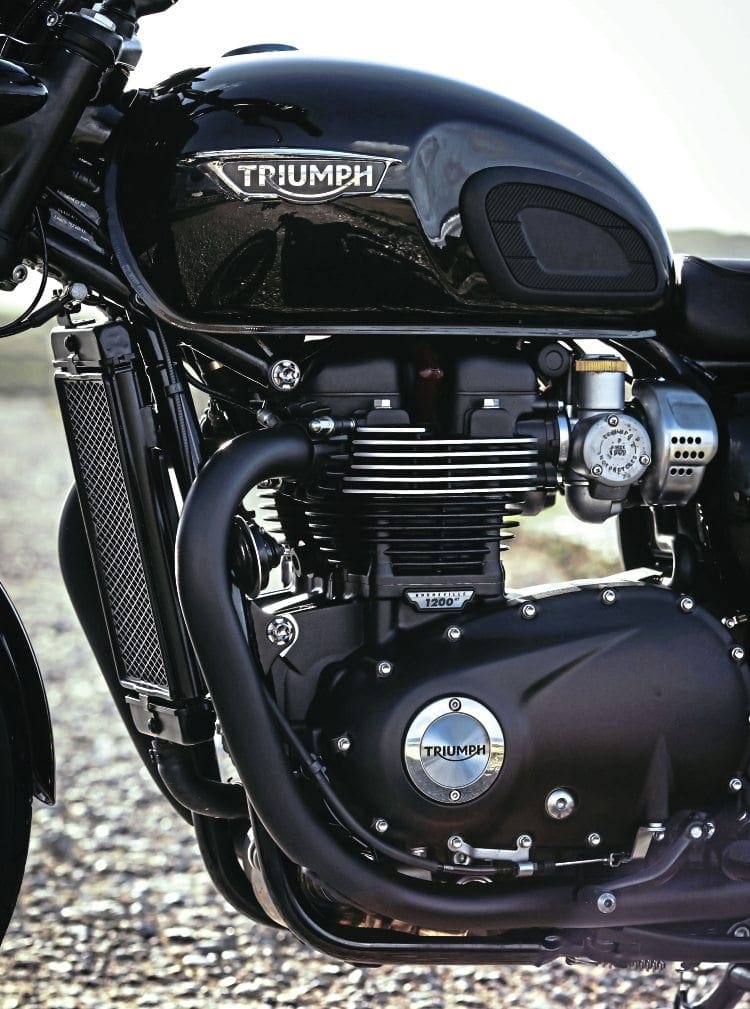
The young journalists were in awe at the care Triumph have taken to make genuine fake Monoblocs while I, as the sole representative of those who had suffered with the (expletive deleted) awful Amals, cowered in a corner with my hands covering my face.
Fake Monoblocs! Aarrrggghh! It’s just as well that fat, bald, old wrinklies like me aren’t the target market…
That Triumph understand their market so well is reflected in the fact that the majority of T120s sold will be in urban cool black – and even cooler matt black. For this article, my editor specifically and explicitly forbade me from riding one of the really attractive Cranberry/Silver T120s and ordered me to concentrate on the urban cool black edition.
There was a certain irony in this edict; looking intentionally cool or authentically high fashion grunge are both skills which have completely passed me by.
So, to the bike. At the heart of all the Bonnevilles, from the Street Twin to the Thruxton R, is an eight valve, air-water cooled twin.
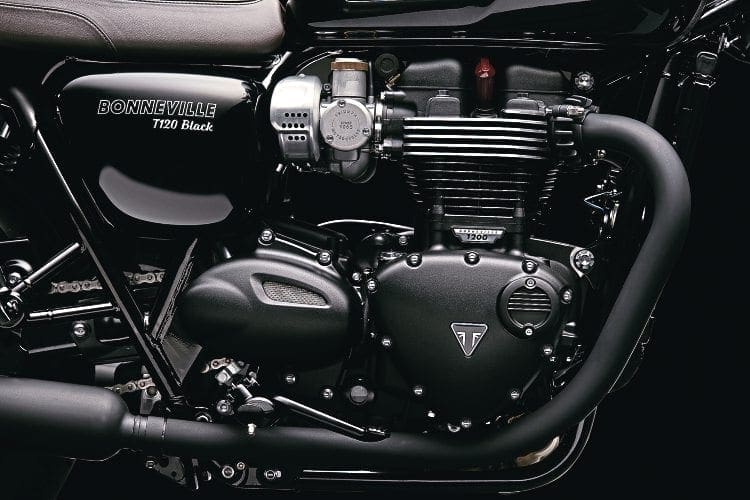
I have deliberately hyphenated the two methods of cooling, to stress that the archetypal splayed cylinder head and heavily finned cylinder barrel are not cosmetic styling affectations but play a significant part in controlling the engine’s temperature.
The liquid cooling part is undertaken by a modest radiator, tucked away between the frame’s twin downtubes. It is so small and neat that it looks not much bigger than an oil cooler.
Hard core Meriden Bonnie acolytes will sneer at the radiator, but it is essential to allow the motor to be built to the ultra-tight tolerances which Euro 4 demands.
The important thing is that the rad is honest. It’s not covered up or disguised, but is simply very neat.
There’s almost no external plumbing on the engine and so, with a bit of goodwill, you can pretend that there is no liquid cooling at all if you are so inclined.
The great big, and very traditional, Bonnie exhaust clamps confirm what you already want to believe. Maybe Doug Hele designed this engine after work at Meriden… but only in the same way that James Bond really did drive his Aston Martin off a cliff and land precisely on the baddie’s truck.
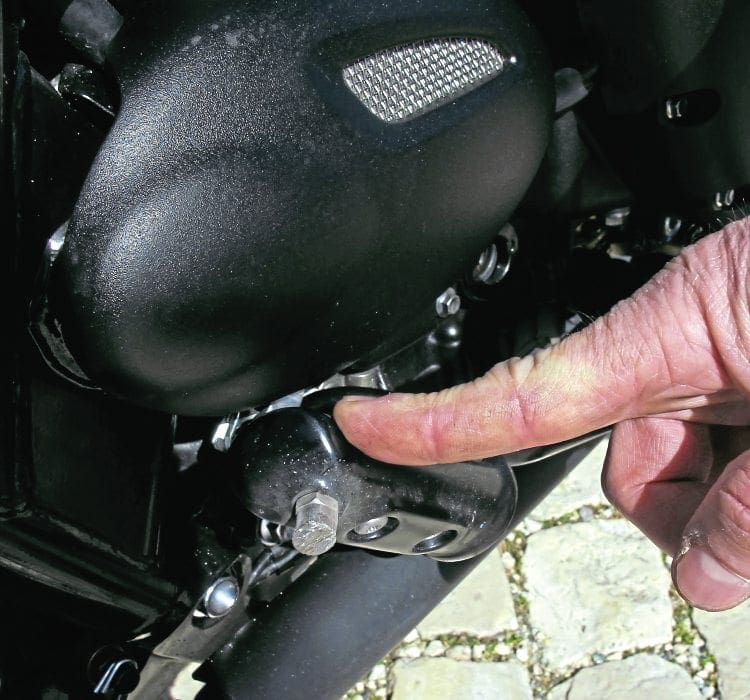
Yes, the engine is theatre – but it’s honest theatre and I love it.
Once you are under the skin there is some clever engineering.
First, the engine is both smooth and yet still extremely anthropomorphic.
Twin, gear-driven counter balancers spin in the opposite direction to the crank for full primary balance and the 270 degree firing order cancels out secondary vibration.
Retro enthusiasts might think that they want a 1968 Bonneville but they conveniently forget that bits dropped off everywhere and those thick, hollow handlebar grips were the only thing stopping the rider from a good dose of white finger disease.
Here’s where things get really clever. Although there is no vibration as such, you can still feel the power impulses of the bike in the background so there is that very strong, organic link with the bike.
It’s things like this which make me so impressed with the job Triumph have done.
With the Bonneville range they have hit the two very elusive targets of being authentically classic while completely modern. There’s nothing fake about the T120 and this is what I like most about it.

The engine is a now a whopping 1200cc thanks to an increase in the bore size to 97.6mm.
The bigger bore has necessitated a new cylinder head, but this is still single overhead cam to keep the engine short and neat.
The reworked engine now makes 54% more torque than the outgoing T100, at a tractor-like 3500rpm. You could pull a trailer load of spuds with this bike!
The gearbox is a lovely, light, sweet six-speeder and is helped by a Torque Assist clutch mechanism.
This system gives a very light feel at the handlebar – it’s almost like riding a 125 or 250 – because there are only three springs on the clutch.
You will be able to ride all day and the clutch will never cause any fatigue.
At the same time, control is excellent. Important, because the T120 will be used in a wide variety of situations from urban commuting to long distance touring.
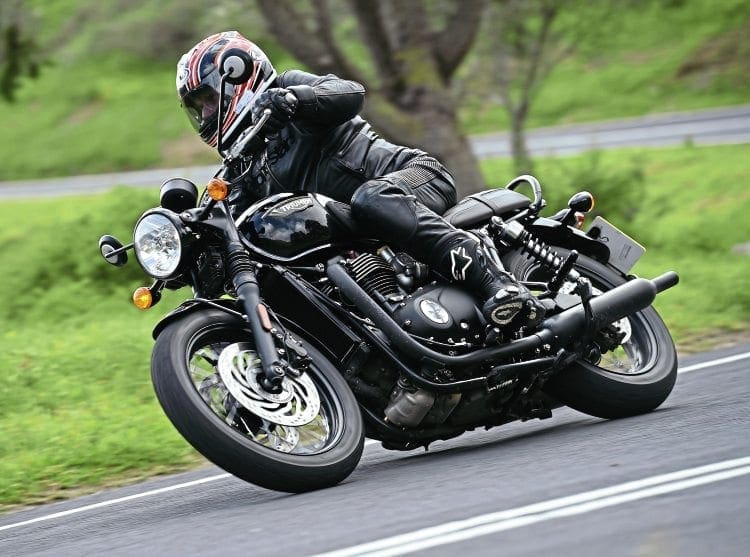
On the day I rode the Bonnie, it rained and was cold. The weather gods must have known I was coming…
On one section of the test route, I ended up in the centre of a small town, stopped, uphill, on wet cobblestones, at a pedestrian crossing.
The T120 was as calm and helpful as a 50cc scooter, as I just trickled in the power and eased the clutch home. Now that really is seriously good, real world engineering.
On the road, the motor will pull hard from nothing and whizzes up to 90mph as fast you want to go. As for top speed – I don’t know and don’t much care either.
I guess that with 79bhp on tap, something past 120mph will be about right – so you can lose your licence comfortably and still have 19mph to spare.
Much has been said about the evils of Euro 4 but things are not turning out as the Eurocrats intended.
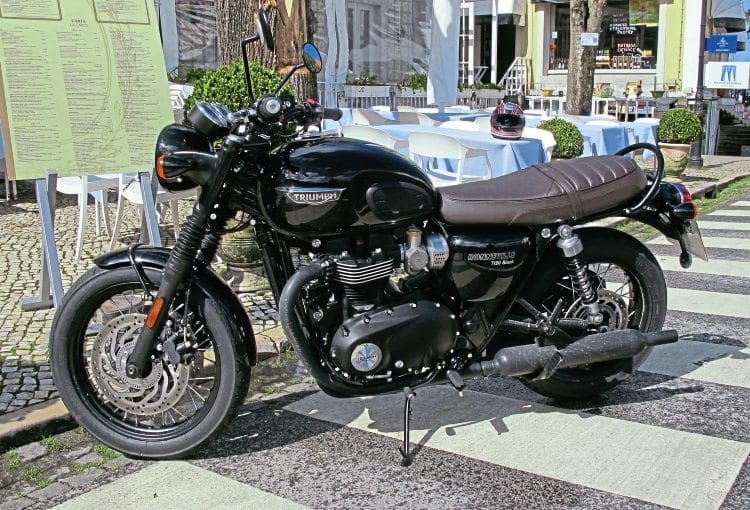
Noise levels are now measured on acceleration and this means that the standard exhaust note can be made to sound really lovely.
Triumph’s Vance and Hines accessory exhausts are truly, appallingly dreadful. They make a discordant racket which completely ruins the bike and the din they make is going to get the non-motorcycling public up in arms. Why Triumph think that this is a smart idea is completely beyond me.
However, one more observation about the exhaust shows what a thoughtful bike this is.
The pipes are double walled. Apparently, cool people don’t like blued pipes or black pipes which go grey.
However, Triumph have also done some clever laser cutting on the inside of the pipes so that there is a completely innocuous link to the very well hidden catalyser.
What a lovely example of having your cake – in terms of looks – and eating it – with Euro 4 compliance.
One of the pleasures of being on a Triumph launch is that senior staff wander around and will talk to you very openly.

The informal conversations I had with Felipe Lopez, the chassis engineer for the Bonneville project, were fascinating – not only in terms of engineering but also the way that the demands of the marketplace can sometimes contradict what is best for the rider.
I have ridden with Felipe and he is ferociously fast on the road, and really does know what he is talking about in terms of handling. Now, here’s where things get interesting.
The T120 has 18in wheels because Triumph’s market research indicates that customers must have 18in wheels so that the bike looks like a Meriden Bonnie.
The snag is that 18in wheels are heavier than 17in rims and therefore have a significantly greater gyroscopic force. This makes the bike harder to turn. Note the adverb ‘harder’ – not hard.
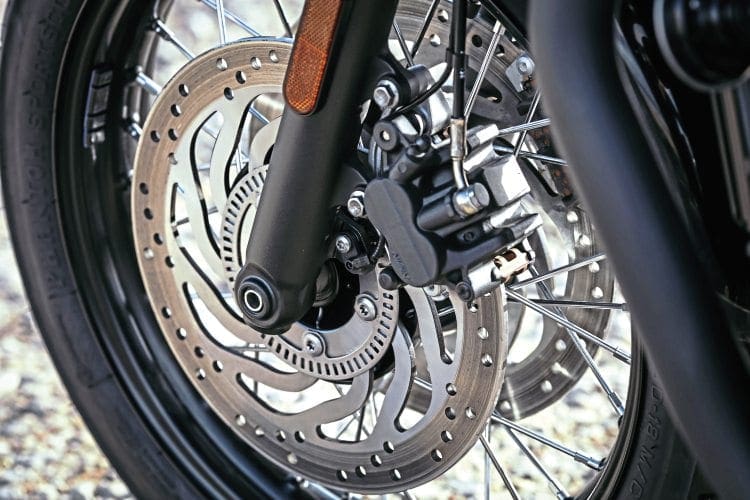
The market also demanded twin discs. Of these, more later.
This meant that the T120 front wheel assembly, including the larger tyre, is 28% heavier than the Street Twin and so, once more, the bigger bike isn’t quite as smooth at the initiation of the turn.
The final problem is that I am convinced that Triumph have chosen too soft a spring for the rear shock.
On the standard, mid-point setting of the shock the T120 squatted down too much on the rear. This in turn made the rake too shallow. It also lowered the bike to a surprising degree and the hero blobs on the footrests took a real hammering.
Talking to the very helpful Lee Vigor, Triumph’s test rider for the T120 who has ridden the bike for 50,000 miles, he reported that he always has the preload on the shock two notches stiffer than standard.
Of course I immediately wanted my test bike set up like his. The effect was instantly better.

The bike turned quicker and more easily into corners, and the extra few millimetres of clearance were the difference between the hero blobs graunching down all the time and just touching down now and again.
The problem with increasing preload is that it is not a fix for a soft spring because you lose the initial part of the spring’s range.
The real solution, especially if you intend touring with luggage or carrying a passenger, will be a stiffer spring – if the damping in the Kayaba shock can handle it.
Should any of this bother you? In the real world, probably not.
Journalists hammering round mountain roads are not representative of mainstream Bonneville customers – but perhaps knowing that there is a simple fix for getting the handling much better may be of some interest to those readers who want to use the T120 hard.
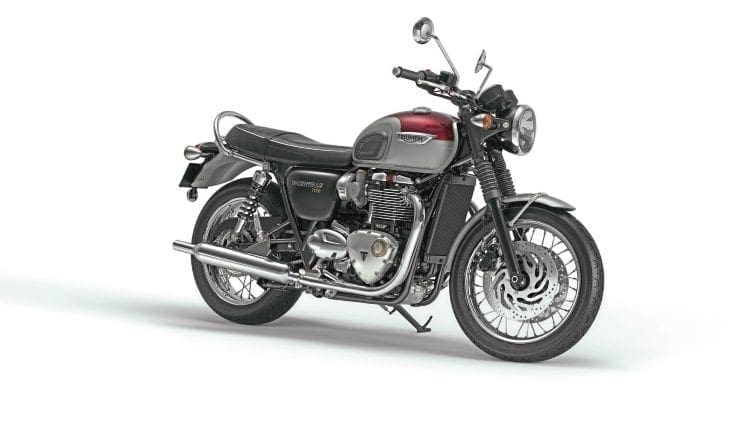
There is a similar story for the brakes. Customers demand twin discs because a Bonneville without them would be emasculated. Sadly for the legend, that’s just not true.
The single disc on the Street Twin is good enough to use on the T120 even if you were riding the man bits off it – and that’s fact.
So when the T120 was fitted with twin 310mm discs, with Nissin’s finest dual-piston floating callipers, they had to be prevented from giving all the power which was available.
In simple terms, if Triumph had fitted two Street Twin discs then the T120 customers would have wet themselves, even with ABS.
When I pressed Felipe on this he went very quiet and changed the subject but, believe me, stick a pair of ECB track day pads in those discs and you will never want more braking power.
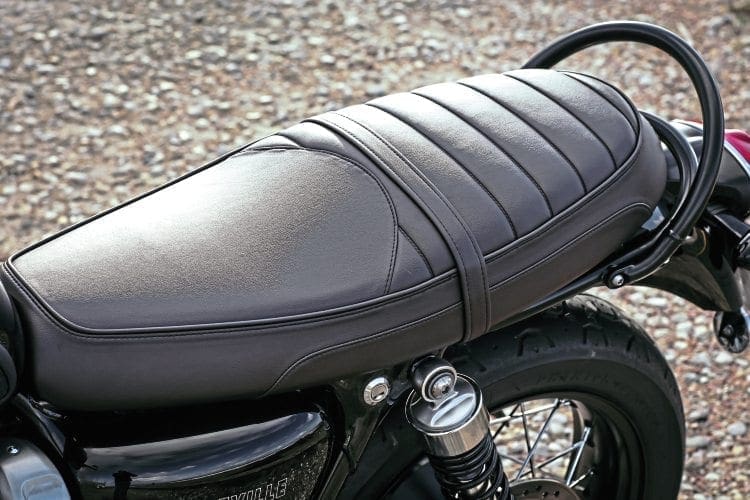
I keep referring to the real world because the Bonnie is a good place to spend a real day, with real pedestrian crossings, real rain, real overtaking and real looking at the scenery.
I am 5ft 10in and there is loads of room for me. The saddle would take a pillion with plenty of room, too.
The saddle has a composite foam construction – rather like a multi-rate spring – and has an initial softness followed by firmness. It’s perfect for a long day’s riding.
It’s easy to reach the floor and yet the riding position isn’t cramped, even for me, with racing destroyed knees.
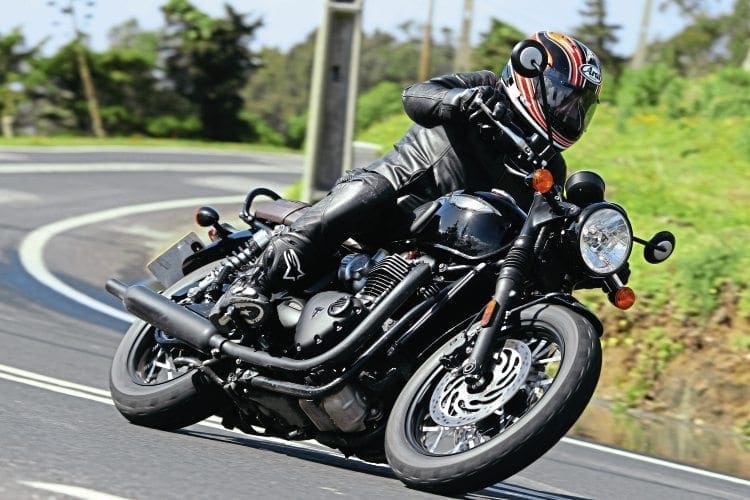
There are also good, sensible things included as standard. The heated grips work really well and what a wonderful thing it is to have a centrestand, especially during the winter lay-off.
Triumph have done well with the bike in terms of never appearing mean with the T120’s standard specification and this is very much to their credit.
The actual bike is almost the tip of the iceberg with the Bonneville experience. There are in excess of 160 accessories, all of which are Triumph-approved, and you can spend your whole year’s motorcycling budget playing about with your T120 until it is absolutely perfect for you.
Most of the bits are easy to fit, by you or the dealer, so you don’t need to be a whizz with a TIG welder or a planishing hammer to make your Bonneville look special.

In summary, the T120 is a thoroughly practical motorcycle which you really could ride down to Geneva, two-up, in a couple of days, challenge the speed limits all the way and have a great time.
Equally, if you want to go for a 20-mile ride after work then the bike will not make great demands of you.
As I’m officially not cool, the dark model doesn’t suit me particularly, but if I could have a Cranberry Red and Aluminium Silver bike, with a nice chromed carrier and maybe a top box, then I would be happy to have the T120 as my one and only road bike.
Although I would still tweak the rear suspension and front wheel brake pads…
THE BEST BONNIE?
OPINIONS VARY ABOUT which was the greatest of all Triumph Bonnevilles.
When the father of the unit construction Bonnie, Doug Hele, says that the best of all was the 1968 model you have to sit up straight and pay attention.
This is how Doug explained it to me when we were chatting about Bonnevilles, long after his retirement as Triumph’s chief development engineer.
“By 1968, we had introduced the last of the chassis changes so the Bonneville handled really well – up to racing standards. Right off the showroom floor there wasn’t a road legal bike in the world which handled as well as a Bonneville.
The engine was fully developed; a standard engine, straight off the production line, produced around 46hp and reliably too. This was enough power for 110mph-plus performance. The four-speed gearbox was good, as was the clutch. Quality control was excellent and the bikes were well built.
“Finally, I don’t think we ever made a more handsome motorcycle than the 1968 Bonneville.”
It’s not only Hele and his development team who feel like this. Ask any of the workers from the old Triumph factory at Meriden which was the best bike they ever made and, nine times out of ten, they will become misty eyed remembering the 1968 Bonneville.
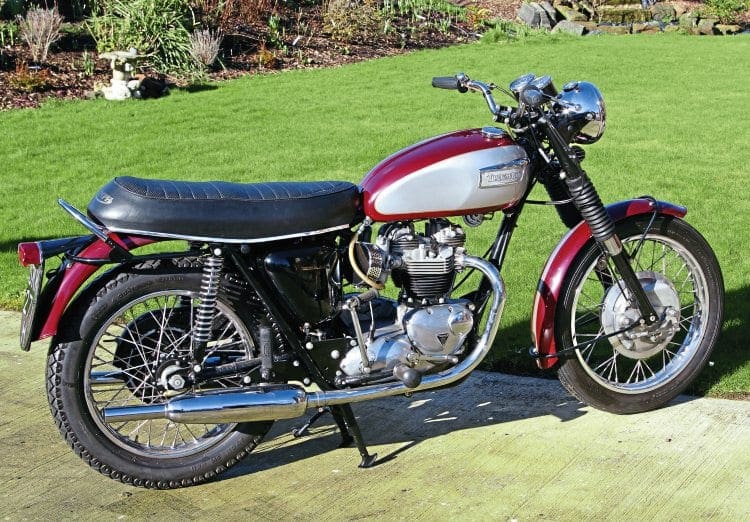
Hele was the key reason that the 1968 Bonnie is so good. Although none of Hele’s designs was particularly ground-breaking or significant in the long term, he was one of the finest development engineers of the old British motorcycle industry.
Doug’s strength was an innate ability to understand how the whole motorcycle functioned. He could produce solutions on paper, because Doug was a trained, professional engineer, but his gift was to sense the interaction between the chassis and engine, much as an artist mixes colours to achieve a perfect result.
Doug’s work was aided tremendously by Triumph’s chief test rider, Percy Tait. Sometimes, Tait’s abilities are understated when he’s pigeonholed as ‘just’ a talented test rider.
In fact, he was far more than this. Any rider who can lead Giacomo Agostini in a Grand Prix, as Tait did in the 1969 Belgian GP, is somewhat more than merely competent.
Had he relinquished his job at Triumph and committed himself wholly to GP racing, then Tait would have been a strong world championship contender.
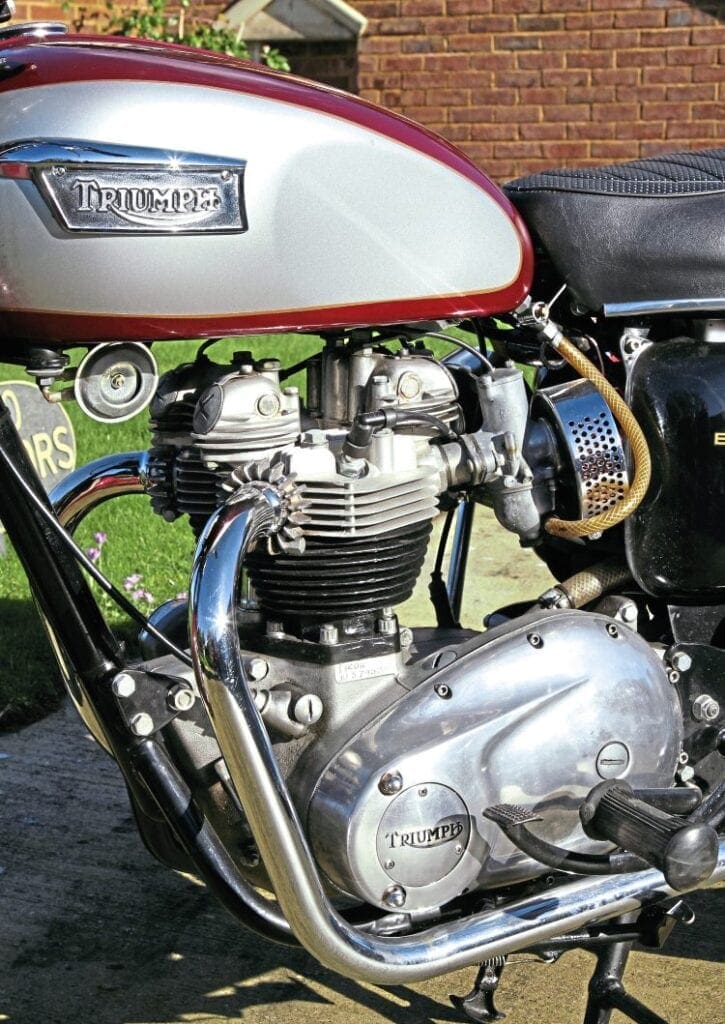
Hele thought highly of Tait’s skills. “Percy was a wonderful test rider – wonderful. He could ride a bike right up to the limits of its performance, and beyond, and still not crash it. He could also do the same thing over and over again, which was a wonderful skill for a test rider.
He had strong opinions too and needed to be convinced by argument and example that an idea worked. I encouraged this. All the team was encouraged to express their opinions and offer their ideas. It was a very happy team and we worked together well.”
So, to the greatest of all the Bonnevilles. The lineage of the 1968 Bonneville could be traced back to the 1948 Triumph Thunderbird which was built to satisfy the American market’s desire for brute horsepower.
The Thunderbird grew into the even faster Tiger 110 and then, in 1958, the factory fitted a hotter camshaft and a twin port, splayed head. A legend was born: the first T120 Bonneville.
Under the direction of chief development engineer Frank Barker, Triumph pursued a policy of chasing power almost at the cost of everything else.
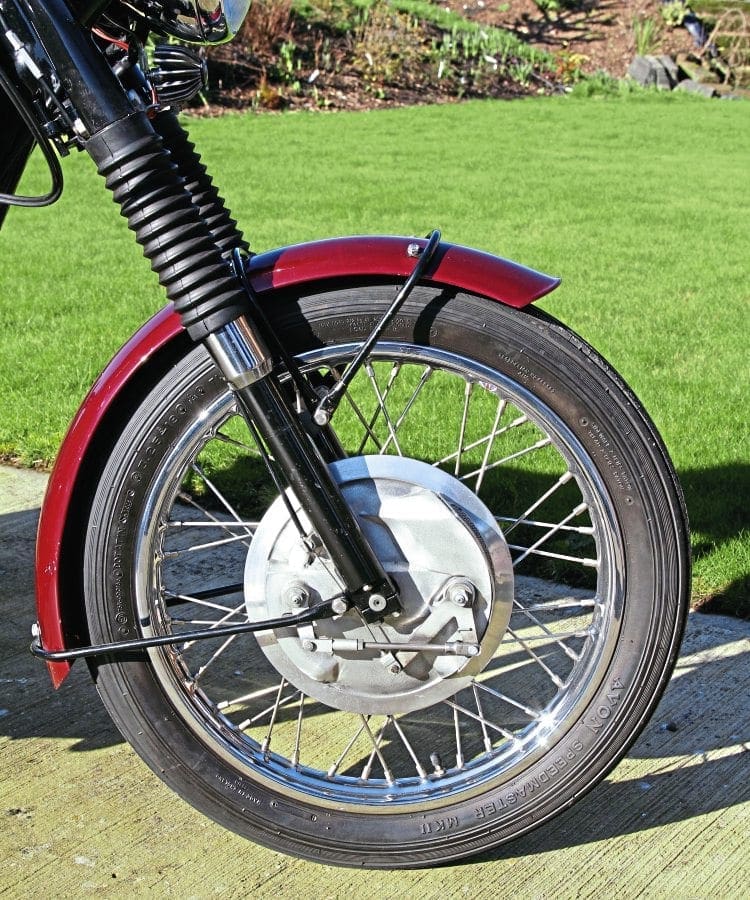
Edward Turner was at his peak in terms of understanding his customer base and he rightly considered that as long as the Americans could buy a blisteringly fast bike then the sales would continue to rise. He was right – but only up to a point.
1962 saw the introduction of a unit construction engine. The motor was neater but, in truth, very little was new, and the handling remained as questionable as ever.
The big breakthrough came in 1963 when Doug Hele joined Triumph from Norton. Hele was a passionate advocate of the ‘whole motorcycle’ concept, where every part of the machine was integrated, to contribute to the bike functioning at its optimum level.
Hele also had a lot of experience of making British parallel twins work as whole motorcycles because he had been the driving force behind the Norton Domiracers.
Hele completely redesigned the Bonneville frame and made many improvements to the already well-developed motor.
The result was a lithe, superb handling bike with a genuine 100mph plus instantly available – and the looks to go with it.
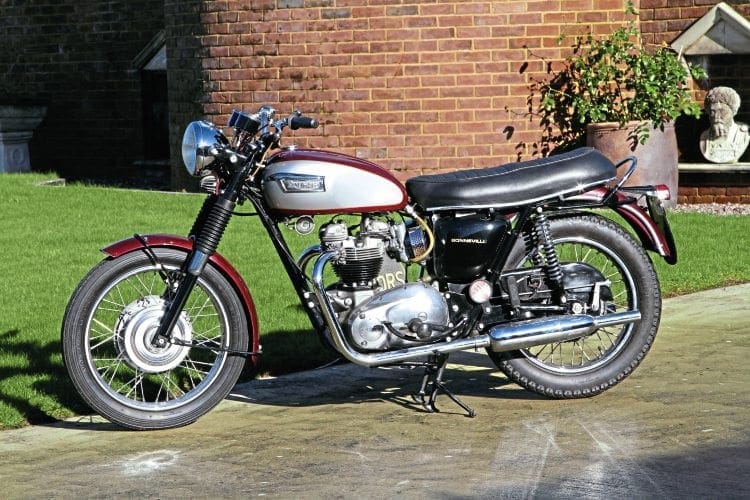
In production racing trim, the bike won the 1969 Isle of Man TT at an astonishing speed of 99.99mph in the hands of Malcolm Uphill, and the bike became a legend in its own lifetime.
The Bonnie was also subject to a steady stream of incremental but important refinements which, little by little, got the bike to its optimum performance.
Importantly, the frame was stiffened. Next, the oil tank capacity was increased to six pints in 1965 – an important change because by the mid-60s a box-stock standard would run well north of 110mph and, used at the top end of its performance range, Bonnies ran hot.
All Triumph twins still followed Turner’s 360-degree configuration. None of the engines carried a counter-balancer and so, while the 350cc and 490cc motors vibrated, the 650cc twins were hand-numbing.
To avoid bits dropping off all over the place, an increasing number of ancillary parts were rubber mounted and the bikes came with thick, partially hollow handlebar grips. This was the lowest of low tech solutions to solving the vibration problem.
Even Triumph’s most loyal customers were getting hacked off with Lucas electrics. By 1968, the Bonnie was 12V but there was no electric starter.

The Lucas zener diodes failed all the time and the lights were unreliable. It was now the late 1960s and Japanese bikes were everywhere, and with electric starters and lights which worked at night merely by switching them on.
Yes, Bonnies were vastly more beautiful, better handling and carried hugely more kudos – but the Japanese were catching up fast.
For 1968, there was another major front fork upgrade which brought the Triumph suspension up to the standard of the world-leading Ceriani design.
The engine received a host of minor mods derived from Triumph’s production racing experience but the major improvement, and it really was an important one, was a brand-new 8in twin leading shoe front brake.
Set up correctly, this really was an excellent brake, good enough for racing. Its rough, unpolished finish also had a rather butch, he-man look about it which chimed with Triumph’s slogan of the time: ‘Triumph – the Man’s Machine.’
The sporting theme was everything to Bonnevilles at the end of the 1960s, as was the influence of the American market.
There was no hint of the dull, staid, sensible, bathtub enclosures carried by the Triumph Thunderbirds at the start of the decade.
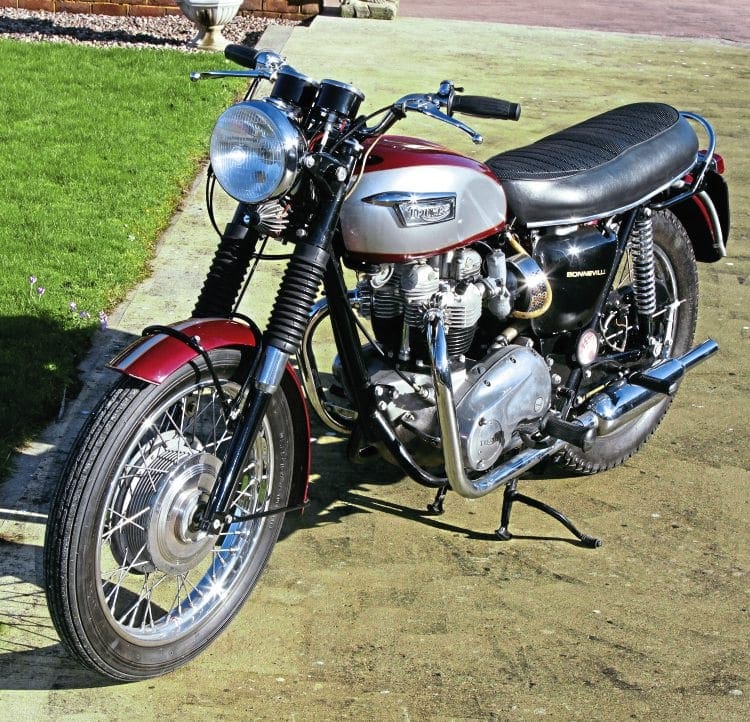
Bonnevilles were slim, racy and dominated by function over form – and they looked all the better for it. Finished in the most beautiful Triumph colour scheme of hi-fi scarlet and silver sheen, the 1968 Bonnie really is a catch-your-breath looker.
A 1968 Bonneville does not have many faults in terms of reliability, handling or braking power, providing the owner remembers that this is basically a prewar design, and doesn’t try to use all of the bike’s 100mph performance on any but the rarest of occasions.
With electronic ignition, the bike starts easily and is one of the few, very few, classics which is truly practical.
The 1968, 1969 and 1970 Bonnevilles are also excellent value in classic motorcycling. Triumph production was at an all-time high in this period: a lot of Bonnevilles were made so there are plenty of these wonderful bikes still around.
Thanks to Lawrence of Classic Motorcycles Ltd (01928 788500) for his help with the photos and info
Read more News and Features online at www.classicbikeguide.com and in the latest issue of Classic Bike Guide – on sale now!




